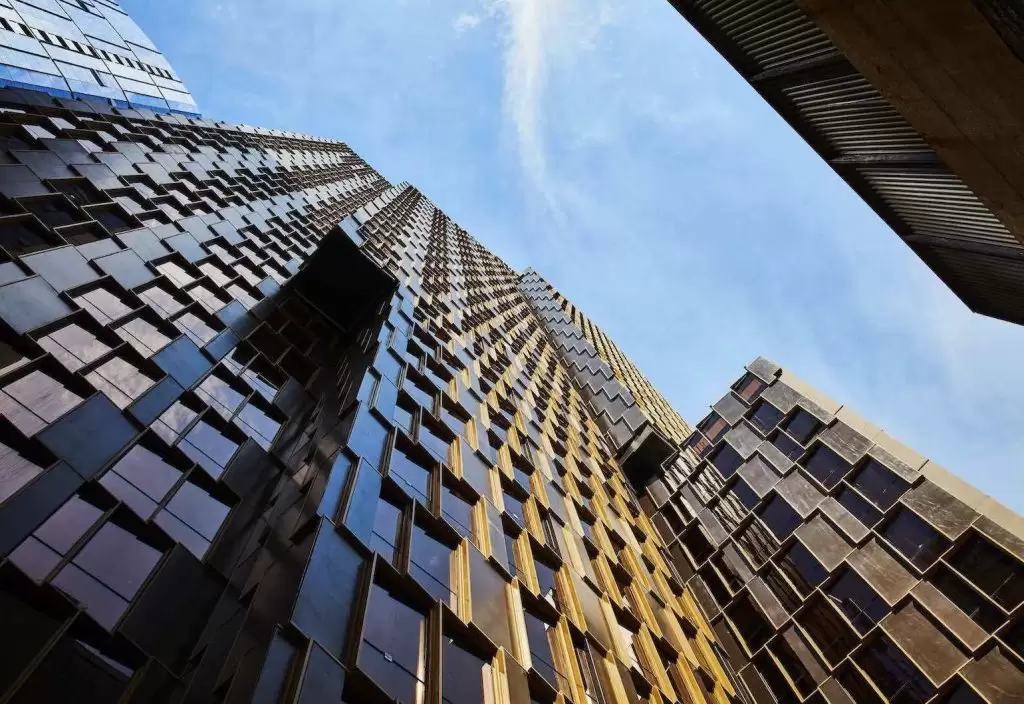Standing 150 m tall, Atira Student Living is one of the tallest buildings in the world to use prefabricated construction methods and has been recognised by the Council on Tall Buildings and Urban Habitat.
How can you construct a 43-storey tower in the heart of Melbourne in just 24 months without causing traffic chaos? Assemble much of it off-site, truck the components to their CBD location at night and stitch them into place like a colossal Lego set.
This simple explanation belies the innovative engineering behind the 150-m tall Atira Student Living, located on Melbourne’s La Trobe Street. Completed in 2018, it is one of the tallest buildings in the world to use prefabricated construction methods, and its articulated snakeskin-like façade is a recognisable part of the city’s fabric.
The structure won recognition from the Council on Tall Buildings and Urban Habitat as well as from the Concrete Institute of Australia. It’s also a fine example of the way engineering is pushing the boundaries of skyscraper construction to make it faster, safer and more sustainable.
In June this year, a study released by University of Cambridge and Edinburgh Napier University illustrated that using volumetric modular systems can produce 41 to 45 per cent less carbon dioxide emissions than traditional methods of building homes. Prefabrication also reduces indirect carbon emissions such as those caused by deliveries and on-site workers since modules are produced offsite in a controlled assembly line environment.
Dr Tim Forman, Senior Research Associate at University of Cambridge, says: “Buildings are responsible for approximately 40 per cent of global energy-related carbon emissions, and there is an urgent need to reduce the carbon intensity of construction and buildings in use.”
The Atira construction methodology is thus a step in the right direction.
Lego-like construction
Atira’s main contractor, Hickory Group, worked with developer Blue Sky Funds, architect Hayball, structural engineering firm Rincovitch and civil engineering practice Advent Consulting Engineers, to apply a new iteration of its innovative Hickory Building System (HBS). This patented technology allows prefabricated buildings to be constructed to greater heights than other modular technology is capable of reaching.
The creation of this award-winning building involved the construction, testing and transportation of 285 HBS modules to Atira’s La Trobe site from Hickory’s factory in Melbourne’s inner-west. The longest piece delivered to site was about 17 m long and weighed 26 t. The on-site construction method utilised a quiet electric crane to deliver and install the modules out of hours to minimise traffic and site congestion during the day.
So, how did engineers ensure all the elements clicked into place?
While structural works were commencing at the Atira site, an engineered concrete floor, load-bearing columns, fully fitted wet areas and building façade were being constructed in Hickory’s factory before being transported to site for installation.
A transfer station at level two was designed to receive the modules from level three and concrete was shot between the units, which allowed the module walls to become integrated with the structural system. This provided the strength and integrity of a traditional high-rise building.
In a conventional tall structure, the floors are built first and then a protective screen is applied so workers can build the core and the internal fit-out. For a building of this height, about 18 floors would have been built before starting on the façade. However, in the case of Atira, the façade was already attached to the modules. And, as it was there from the very start, it acted as the protective screening for the workers inside.
[embedyt] https://www.youtube.com/watch?v=SmHmpF1p2H0[/embedyt]
Engineering at its best
The 783-bed Atira building includes a series of terraces, lounge areas and other communal spaces where students can study and socialise. It also features 629 bathroom pods, which were pre-fitted and finished with all the required plumbing, lighting, joinery, wall and floor coverings. When completed, they were craned into position on site.
As the modules were built in a controlled factory environment, there was less need for the construction crew to work at heights, and this improved personal safety. It also allowed for quality control checks to be conducted more effectively when compared to conventional in-situ construction systems.
Elements such as tongue joints, which clicked the modules into place on site, were also tested at Swinburne University’s Smart Structures Laboratory and prototype testing was completed in Hickory’s factory.
Sustainability was also a key objective for Atira’s engineers. For instance, as more precast elements were required to carry the building’s load, all of the temporary steel columns were recycled.
Charbel Nasr, structural engineer and a director at Rincovitch says this prefabricated skyscraper is an example of engineering excellence. He describes the building approach as “pro-innovation”.
“It’s more challenging than a conventional building, because everything has to be 100 per cent coordinated prior to installation,” he says. “There is very little margin for error. This means there are a lot of processes to go through prior to the prefabrication being done and prior to the modules being delivered to site.”
Reshaping our cities
Thanks to some inspired engineering, this 43-level structure was essentially built on the ground floor.
While it took about an hour to deliver each module from the factory to the construction site, it took less than five minutes to put each piece into place while the city was sleeping. This method of construction also enabled Atira to be completed up to 30 to 40 per cent faster than using conventional methods.
Atira’s team of engineers were selected for their ingenuity and desire to achieve a better way of building. It’s this kind of creativity that’s reimagining – and re-engineering – how we construct our city centres.
This article was originally published in July 2019 and has been updated in July 2022.
